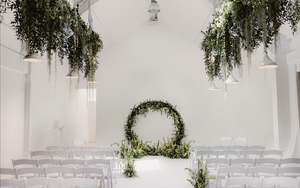THE idea first emerged 11 years ago and this Friday one of the biggest ever exhibitions of Pre-Raphaelite paintings finally comes to fruition - in Liverpool.
Around 120 works, by mid 19th century radicals including Rossetti, Ford Madoc Brown, William Holman Hunt and John Everett Millais, will be on show at the Walker until June, some never before seen by the public.
It will cost £7 (£5 concessions) to get into the show, one of the rare times in the Walker’s history that visitors have had to dig into their pockets.
Given that such an exhibition is unlikely to be repeated anywhere in the next few decades, coughing up a few quid seems, well, you decide.
National Museums Liverpool, which runs the Walker, cites the cost of assembling and carefully transporting the vast exhibition, with paintings, worth millions of pounds, borrowed from galleries and private collections around the country. Around a third of the paintings are owned privately and not normally on public show.
Aside from stunning paintings, there is an intriguing side show to the exhibition: the untold story of Liverpool’s importance in the emergence of the Pre-Raphaelite community, rivalling London’s art scene.
When they were first painted in the mid 19th century, this sort of work was regarded as an affront. Whereas those other artists (who came after the Renaissance painter Raphael) tended to idealise religious figures, the Pre Raphaelites went back to basics with warts-and-all realism.
Colours were bright and stood out. Subjects were controversial: poverty, emigration, prostitution and sexual morality in society. They were deemed morally shocking, even blasphemous.
This is a tale of artists, patrons and the moneyed Liverpool customers who snapped up paintings that the more conservative collectors in snobby London didn’t want to touch.
The exhibition introduces the collectors who were both friends and supporters of the Pre-Raphaelite Brotherhood - described as the first modern artists. Collectors such as John Miller, Frederick Richards Leyland and George and Julia Rae enabled a group of revolutionary and controversial painters to change the face of British art in the 19th century.
One of the paintings is a little known Pre-Raphaelite treasure, ‘The Salutation of Beatrice’ painted by Rossetti 135 years ago, and on show for the first time ever in public. Around a third of the exhibits have been borrowed from private collectors, giving art lovers a rare chance to see them in public.
The fascinating Salutation belonged to Rossetti’s close friend and major patron Frederick Leyland, a Liverpool-born ship owner and art collector. It is still owned by the descendants of Leyland. Another Rossetti from the Leyland collection has also never been seen in public with a third work last shown in public 140 years ago.
A smaller painting, The Hay Loft, also known as Catnap, was painted in 1858 by Rosa Brett and is privately owned. It features a seemingly innocent image of a snoozing cat, but discarded clothing close by suggests less than innocent activities taking place elsewhere in the barn.
When the painting was exhibited in Liverpool in 1858 at Brett’s debut exhibition, she used a male-sounding pseudonym to hide the fact the work, with its secretive hint of passion, was by a female artist.
 Walker Art Gallery, National Museums Liverpool.jpg) Burd Helen, 1856, William Lindsay Windus
Burd Helen, 1856, William Lindsay Windus The book accompanying the exhibition gives graphic details of the art scene in Liverpool. It tells the story of how the press at the time were critical of Liverpool’s ‘love’ of the Pre-Raphaelite style, the rivalries between followers new style and traditional art. It’s clear for some decades there was a vibrancy in the city’s artistic community never seen before or since.
It tells how Avante Garde Liverpool, inspired by William Roscoe, embraced new art, helped by his support for the establishment in 1810 of the Liverpool Academy, which in its early days featured in its exhibitions the works of people like Turner and Constable. The academy came up with a brilliant idea – offering to pay the full costs of transporting works to Liverpool, and paying for their return for anything unsold. The idea paid off, and the famous artists of the day were happy to embrace Liverpool.
Christopher Newall, internationally recognised as a leading expert on Victorian and Pre-Raphaelite art, has curated the Walker blockbuster, and offered an insight into the ‘Liverpool connection’
 Manchester City Galleries.JPG) The English Boy, 1860, Ford Madox Brown (c) Manchester City Galleries
The English Boy, 1860, Ford Madox Brown (c) Manchester City GalleriesThe merchants and business people of early Victorian Liverpool snapped up paintings from this new breed of painters, eager to decorate the plain walls of their new town houses and villas.
Newall said canny art collectors of Liverpool preferred to cut out the ‘middle man’ and deal directly with the artists, with many close friendships formed between artist and customer.
It was in 2004 that Newall discussed with Liverpool’s art supremo Julian Treuherz, the idea of a major Pre-Raphaelite exhibition as part of the 2008 culture year programme. It didn’t happen, but the idea was never lost and five or six years ago, it rose to the top of the ‘to do’ list.
The exhibition, ‘Pre-Raphaelites: Beauty and Rebellion’ runs at the Walker until June 5, and tells for the first time how the Liverpool of Victorian England played a major in the success of Pre-Raphaelite art.
Newall said the exhibition will reveal, for the very first time, how Liverpool influenced an art movement that would change the course of British art in the 19th century.
He said: “The support of the city of Liverpool was invaluable in establishing and positioning Pre-Raphaelitism within the Victorian art world. This exhibition explores different aspects of patronage, art politics and of the careers of the artists who lived in Liverpool in a way that no exhibition has previously done. This is an exhibition of national, if not international significance. Something on this scale is unlikely to be repeated for at least 20 years.”
Sandra Penketh, director of Art Galleries at National Museums Liverpool, said: “It’s so exciting to see this wonderful exhibition come to fruition. For many years, we’ve planned to tell the story of the Pre-Raphaelites through a Liverpool lens and, with the help of Christopher Newall’s expertise, we have achieved this. The Pre-Raphaelite movement is an incredibly appealing one and we’re sure that our visitors will love the exhibition and be fascinated by the new stories it reveals.”
*Pre-Raphaelites: Beauty and Rebellion runs at the Walker Art Gallery from 12 February to 5 June 2016.Tickets for are available to purchase online, priced at £7 for adults and £5 for concessions, or on the day at the Walker Art Gallery. The exhibition is free to anyone aged 18 and under and discounted tickets are available for existing members of National Museums Liverpool and other selected groups.














